Alumni doctors, administrators, and even students participated Friday in the first-ever Healthcare Affinity Reunion. Additional sessions will be held Saturday on campus.
Wabash Pre-Health Advisor Jill Rogers kicked off the two-day gathering by talking about the challenges Wabash students face entering medical school. She answered physicians' questions and called on students to talk about their medical school interviews.
Friday afternoon featured three 45-minute sessions.
.jpg) Mission Statement in Action
Mission Statement in Action
An alum, professor and current student talked about different projects around a common theme of “living humanely.”
Jake Ezell '11 told the gathered doctors about Wabash’s new chapter of the Foundation for International Medical Relief for Children. Ezell organized the group last year just in time for a medical mission trip to El Salvador over spring break.
The Indianapolis native talked about using language and games as a way to bridge the Salvadorian culture gap and to educate the locals on good health care topics. FIMRC started last spring with seven members and has grown to 42 this fall.
He told the doctors he was hoping some would agree to join future trips planned for spring and summer breaks.
Professor of Biology Eric Wetzel followed with a brief overview of his time in Lima, Peru during his sabbatical leave. Wetzel has a keen interest in neglected tropical diseases and how they affect so many different aspects of life in countries like Peru.
.jpg)
“These are diseases of the poor,” he said. “The issue of living humanely is something we don’t talk about enough.”
Wetzel visited cities, the rainforest, and Andes mountain regions to learn about the different type of health problems Peruvians face. He hopes to begin some sort of global initiative involving the Wabash community.
“My goal isn’t to get more students into medical school, it’s to disturb their lives,” Wetzel said. He hopes anyone making the trip to Peru or learning more about the health challenges will help bring about positive change whether it’s through medicine or other means.
 Dr. John Roberts ’83
Dr. John Roberts ’83 wrapped up the first session with a presentation on Montgomery County's efforts to start a Volunteers in Medicine Clinic in Crawfordsville. VIM has 70 clinics in 24 states with four in Indiana.
He reviewed some of the history of local indigent care and plans to provide care to the approximate 4,000 uninsured Montgomery County residents beginning some time in 2011.
- Howard W. Hewitt
Massachusetts' Healthcare a Model
John Sunde, Vice President and Chief Operating Officer of Baycare Health Partners, discussed the administrative side of healthcare and the impact that Massachusetts’ 2006 healthcare reform has on American healthcare.
After providing an insight to the evolution of healthcare, Sunde described Massachusetts’ 2006 health care reform as a call to action and a step in a positive direction. The reform has insured 400,000 people, lowering Massachusetts’ uninsured rate to 2.6 percent (the lowest in the United States).
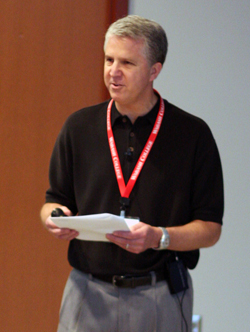
Though the reform helped shape President Obama’s healthcare reform, it has its cons, Sunde said. Problems with the reform include: increased demand, access to care, premium costs and the consistency of the care’s value.
American healthcare is highly favored by other nations, yet the American life expectancy at birth is lower than nations, such as Great Britain and France; and its obesity and diabetes rates tower over other nations. American healthcare costs also vary by location. For instance, the cost of healthcare in Miami, FL is 2.5 times more than healthcare in Minneapolis, MN. According to Sunde, it is a result of supply and demand.
He suggested that a successful healthcare reform requires an abundant amount of participation and that achieving affordability will be difficult. “Universal coverage isn’t sustainable without controlling the growth of spending” and “does not equate to universal access.”
Sunde’s presentation covered a wide variety of factors in healthcare and how the Massachusetts reform can be a step closer to the answer of such a controversial topic. In any light, a healthcare system that works for all Americans will be difficult to achieve.
“Our industry enables miracles to happen every day,” Sunde said. “Will the next one be a health care system that works for all Americans?” - John Dykstra '13
The Other Side of Healthcare
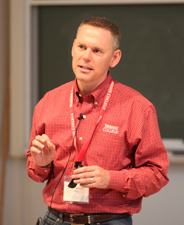
David Callecod ’89 is President/CEO of Lafayette General Medical Center, a four-hospital healthsystem in Lafayette, Louisiana. Since his arrival in July 2008, Callecod has led Lafayette General to rapid improvement in both patient satisfaction and quality measurement. Terry Hamilton ’89 is Senior Vice President, Operations, for St. John Providence Health System, a network of seven hospitals with annual revenue of $2 billion.
As senior leaders in hospital systems, the two are very aware of what the healthcare reform bill means for their systems. Cuts in Medicare payments began immediately and with higher thresholds for acceptance into the Medicaid system, those numbers will imminently increase.
Callecod spoke about the increase of physicians employed by hospital systems as opposed to private practice and the move away from ownership of ancillary services such as radiology and outpatient surgery centers. “There are fundamental changes coming in healthcare,” Callecod said. “There are a lot of unknowns but we [physicians, administrators, ancillary care sights] are going to have to work together. If we don’t figure out how to fix this who will?”
He said his hospital system is looking at this as an opportunity to provide better care all around for their patients.
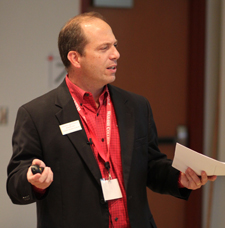
The Detroit area where Hamilton’s system is located has been very hard hit by the recession. The unemployment rate at its highest was nearly 29 percent and there are some zip codes within the metro area where fewer than 10 percent of the available residences are occupied. “This is a community in tremendous need.”
Hamilton shared stories of high foreclosure rates, high levels of poverty, and vast groups of people unable to afford healthcare. “Things in Detroit are so bad that healthcare reform will be good for us,” Hamilton said. “But the question is whether what is good for Detroit is good for the rest of the nation.
“How are we going to pay for it? That’s a huge question but the good thing is it’s a great opportunity to really help people who need it.”
Between Walls: Reflections on Health Systems in Indianapolis and Kenya Reform
Dr. Robert Einterz ’77 is Associate Dean for Global Health and Professor of Clinical Medicine at Indiana University School of Medicine. In 1989, he co-founded the partnership between Indiana University and Moi University, Kenya. He served as the interim coordinator of the Department of Medicine at Moi University in 1990-91. As the partnership grew, the groups began tackling the AIDS epidemic in Kenya and multiple projects led to the establishment of AMPATH (Academic Model Providing Access to Healthcare), a comprehensive system of health care delivery, research and training in western Kenya.
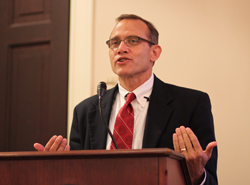
Einterz spoke briefly about the development of the AMPATH program out of a desire he and his partners had to give their colleagues the same opportunities to work in developing countries as they had. This program now serves a population of nearly 2 million people, including care for more than 110,000 HIV infected individuals. Einterz made clear that while his shared vision helped start the program, the program is led by Kenyans. That’s what makes it so powerful.
He shared many stories about individuals the clinics had helped and how many of those people had gone on to serve others through prevention, further education, and treatment.
He also shared stories of how the program has progressed. One patient who refused to go to the hospital was being treated orally at home. She was not responding to the medication. Upon further investigation they discovered she was not eating. What little food she was able to obtain she gave to her children. Once her basic need of food was provided she began to get better. So, Einterz said, “We’re Hoosiers. What do we do? We farm.” They started a farm in Kenya – taught the Kenyans to farm and build irrigation systems. The farm now provides food for 30,000 people.
He challenged the medical professionals in the room that indeed they have the obligation to provide medical care and charity care but also the responsibility to work for justice and make real and lasting change to ensure everyone gets healthcare.
Einterz thanked Wabash for the liberal education he received that inspired him to make a difference mentioning a few of his mentors such as Baker, Stern, Zimmerman, McKinney, and Phillips but he also acknowledge those professors who are here now teaching his own son, “every bit as inspiring and hard working as his mentors.”
Lessons for Health Professionals as the Greatest American
Dr. Richard Gunderman ’83 is Professor of Radiology, Pediatrics, Medical Education, Philosophy, Liberal Arts, Philanthropy, and in the Honors College at Indiana University, where he also serves as Vice Chair of Radiology.
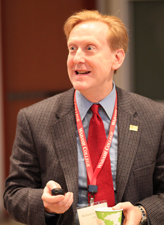
In his presentation he introduced who he feels is the greatest American, if not also the first American, Benjamin Franklin. He spoke about Franklin as a thinker and more importantly, one who was always seeking new knowledge.
Gunderman introduced the “junto” which Franklin founded when he was 21. Gunderman defined the junto as “like-minded aspiring artisans and tradesmen who hoped to improve themselves while they improved their community.” Franklin’s founding junto was a dozen friends who met on Friday nights in a tavern to answer a group of fundamental questions. He introduced each question and explained its importance for health care professionals.
The first question, “Have you read anything remarkable? Medical education turns the brightest into those who do not have time to read,” Gunderman said. “We can only be as good as the ideas we live with and we get those ideas from books. I we don’t have time to read, we don’t have time to live.”
“Have you heard any good story? We are recreating our world everyday by the stories we tell ourselves. How much knowledge is dormant because we build up silos in our organizations and don’t share with each other.
“Do you know anyone who had failed lately, and why?” Gunderman said, “I can’t even admit to myself let alone discuss it with a colleague.” Yet, he concludes we have much to learn from our own and others’ mistakes.
Through a dozen questions Gunderman challenged the group to open up boundaries, “Be willing to step outside the paradigm and ask hard questions.” If we continue to only work within our own blinders then think of the possibilities that will be left unexplored.
- Kim Johnson
.jpg) Mission Statement in Action
Mission Statement in Action.jpg) “These are diseases of the poor,” he said. “The issue of living humanely is something we don’t talk about enough.”
“These are diseases of the poor,” he said. “The issue of living humanely is something we don’t talk about enough.” Dr. John Roberts ’83 wrapped up the first session with a presentation on Montgomery County's efforts to start a Volunteers in Medicine Clinic in Crawfordsville. VIM has 70 clinics in 24 states with four in Indiana.
Dr. John Roberts ’83 wrapped up the first session with a presentation on Montgomery County's efforts to start a Volunteers in Medicine Clinic in Crawfordsville. VIM has 70 clinics in 24 states with four in Indiana. Though the reform helped shape President Obama’s healthcare reform, it has its cons, Sunde said. Problems with the reform include: increased demand, access to care, premium costs and the consistency of the care’s value.
Though the reform helped shape President Obama’s healthcare reform, it has its cons, Sunde said. Problems with the reform include: increased demand, access to care, premium costs and the consistency of the care’s value. David Callecod ’89 is President/CEO of Lafayette General Medical Center, a four-hospital healthsystem in Lafayette, Louisiana. Since his arrival in July 2008, Callecod has led Lafayette General to rapid improvement in both patient satisfaction and quality measurement. Terry Hamilton ’89 is Senior Vice President, Operations, for St. John Providence Health System, a network of seven hospitals with annual revenue of $2 billion.
David Callecod ’89 is President/CEO of Lafayette General Medical Center, a four-hospital healthsystem in Lafayette, Louisiana. Since his arrival in July 2008, Callecod has led Lafayette General to rapid improvement in both patient satisfaction and quality measurement. Terry Hamilton ’89 is Senior Vice President, Operations, for St. John Providence Health System, a network of seven hospitals with annual revenue of $2 billion. The Detroit area where Hamilton’s system is located has been very hard hit by the recession. The unemployment rate at its highest was nearly 29 percent and there are some zip codes within the metro area where fewer than 10 percent of the available residences are occupied. “This is a community in tremendous need.”
The Detroit area where Hamilton’s system is located has been very hard hit by the recession. The unemployment rate at its highest was nearly 29 percent and there are some zip codes within the metro area where fewer than 10 percent of the available residences are occupied. “This is a community in tremendous need.” Einterz spoke briefly about the development of the AMPATH program out of a desire he and his partners had to give their colleagues the same opportunities to work in developing countries as they had. This program now serves a population of nearly 2 million people, including care for more than 110,000 HIV infected individuals. Einterz made clear that while his shared vision helped start the program, the program is led by Kenyans. That’s what makes it so powerful.
Einterz spoke briefly about the development of the AMPATH program out of a desire he and his partners had to give their colleagues the same opportunities to work in developing countries as they had. This program now serves a population of nearly 2 million people, including care for more than 110,000 HIV infected individuals. Einterz made clear that while his shared vision helped start the program, the program is led by Kenyans. That’s what makes it so powerful. In his presentation he introduced who he feels is the greatest American, if not also the first American, Benjamin Franklin. He spoke about Franklin as a thinker and more importantly, one who was always seeking new knowledge.
In his presentation he introduced who he feels is the greatest American, if not also the first American, Benjamin Franklin. He spoke about Franklin as a thinker and more importantly, one who was always seeking new knowledge.